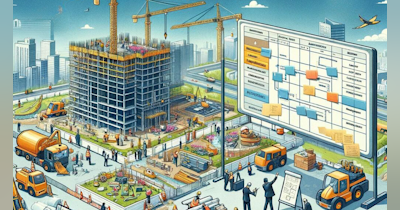Welcome to a new era of construction project management, where the Scrum framework and the Happiness Metric are transforming the industry from the ground up. If you're unfamiliar with Scrum, it's a flexible, collaborative approach initially developed in the 1990s and is now widely used across several industries like construction. Its principles of incremental improvement, transparency, and team autonomy are universally applicable. In complex construction, where projects often run over time and budget, Scrum offers a way to streamline processes, improve communication, and ultimately deliver better results. One key aspect of Scrum is the Happiness Metric, like Team Health, used on highly collaborative projects. This pattern measures team satisfaction, which research has linked to increased productivity and better project outcomes. Design and construction project leaders can foster a more engaged, motivated, and effective high-performing team by focusing on team happiness.
Scrum Basics for Design and Construction Leaders
Scrum is a framework like scaffolding that allows us to get close to and build parts of our projects. It emphasizes iterative progress, team collaboration, and the flexibility to adapt to emerging realities. Unlike traditional project management approaches in construction, which often follow a linear, sequential process, Scrum promotes a more flexible and collaborative approach. Traditional methods typically involve distinct stages and a top-down management style, whereas Scrum encourages self-organizing teams to work on tasks in short iterations or 'Sprints.' These differences allow for regular feedback and adjustments, making it easier to accommodate changes and unforeseen challenges. Using Scrum can lead to more efficient workflows, improved communication, and, ultimately, better and faster project outcomes. If you want to start with Scrum now, tap this link to get started in less than 30 minutes.
Happiness Metric Tips and Best Practices
The Scrum Happiness Metric Pattern is a method used to gauge the satisfaction and engagement of a team in an Agile or Scrum environment. It is based on evidence that a happy team is more likely to be productive and effective. However, it's important to note that happiness is not the sole focus of this metric. It's about tapping into a broader sense of value and an emotional spectrum beyond happiness. The pattern encourages teams to focus on improvements that will improve the team's workplace and enhance the overall quality and satisfaction with the project.
Let's break down the Happiness Metric implementation into actionable steps:
- Introduce the concept to your team. Explain the concept and benefits of measuring happiness.
- Develop a simple survey using MS Forms, Google Forms, or other similar survey tools at your disposal. Make it an anonymous survey using a five-point scale. Keep reading for an example below.
- Focus on incremental improvements. Encourage the team to aim for small changes to increase happiness over time.
- Conduct the survey regularly. Implement regular surveys to track happiness levels over time, like monthly or quarterly, for longer projects and something more often for shorter ones.
- Reflect and adapt with the results as a team. Discuss potential improvements based on the feedback received, especially the open-ended questions.
- Acknowledge the limits of the pattern. While happiness correlates with performance, it is not the sole predictor of success.
- Foster awareness and engagement to increase organizational self-awareness. Engage the team in ongoing discussions about happiness and improvement efforts.
Survey Example:
1. How would you rate your current level of happiness?
- 1 (Very Unhappy)
- 2 (Unhappy)
- 3 (Neutral)
- 4 (Happy)
- 5 (Very Happy)
2. How would you rate your current happiness with your job role and responsibilities?
- 1 (Very Unhappy)
- 2 (Unhappy)
- 3 (Neutral)
- 4 (Happy)
- 5 (Very Happy)
3. How would you rate your current happiness with your company?
- 1 (Very Unhappy)
- 2 (Unhappy)
- 3 (Neutral)
- 4 (Happy)
- 5 (Very Happy)
4. What would increase your happiness? (Open response)
5. Do you have any other comments or suggestions? (Open response)
Note:
While focusing on emotional and personal outcomes, remember to remain adaptable and open to refining the process based on experiences and results.
Best Practices for Construction Leaders
- Purpose: The team members must share a sense of value and be focused on the whole project. They should clearly understand the project's goal and how their roles contribute to it. This sense of purpose is central to happiness and can lead to improved performance. Don't start with the Happiness Metric until you get this understood by the team first.
- Autonomy: Giving the team a stronger sense of autonomy can increase happiness and engagement. However, autonomy alone won't carry the day. It needs to be connected to a purpose that transcends the individual. The voice of the customer is compelling for this, like this example, "Open the school by August 15th to foster a learning environment for kids used to overcrowded schools."
- Engagement: The Happiness Metric Pattern suggests people feel more personally connected to and committed to improvement when happy. This engagement can lead to improved team performance. However, it's important to note that established happiness leads to good performance more than good performance makes employees happy.
- Honesty: Happiness can indicate moving towards the project's greatest value if the team is cautious and honest with itself.
- Balance: Happiness is highly correlated with performance, but it cannot support any non-emotive business goal.
Implementing Scrum and the Happiness Metric in construction projects can lead to transformative results change makers like you want to experience on your project. Project leaders can anticipate a significant positive shift in their project outcomes by focusing on incremental improvements, fostering a sense of autonomy, and measuring team happiness. The Scrum framework with this pattern encourages teams to focus on one improvement at a time, ensuring that the effects of each change are clear and measurable.
The Happiness Metric is about measuring happiness and understanding what makes a team more effective and what obstacles are standing in their way. This metric can help teams feel more personally connected to and committed to their improvements, leading to increased engagement and better performance. By implementing these strategies, construction project leaders can expect improvements in project delivery times, budget adherence, and overall team satisfaction. More importantly, they can look forward to creating a work environment where everyone feels valued, motivated, and happy. These actions unleash the true power of Scrum - transforming not just projects but people and organizations as well.
Learn More with "Construction Scrum"
To all the eager learners and industry enthusiasts wishing to delve deeper into the intricacies of Scrum in the construction domain, your pathway to becoming adept is just a read away. "Construction Scrum" is not just a book but a reservoir of tried and tested methods, rich with practical insights tailored for construction project managers. Whether you're starting fresh or looking to enhance your existing knowledge, this book serves as a beacon, guiding you through the practical application of Scrum principles in the ever-dynamic field of construction. By incorporating real-world examples and success stories, "Construction Scrum" presents a robust framework that promises applications of theoretical knowledge and a ladder to escalate your project management skills to new heights. Embark on this enlightening journey and unlock a new perspective on construction project management, one Scrum principle at a time. Find your copy and step towards a happier, more productive, and autonomous work environment. Tap this link below to learn more and access my favorite parts of the book for free. https://constructionscrum.com/











